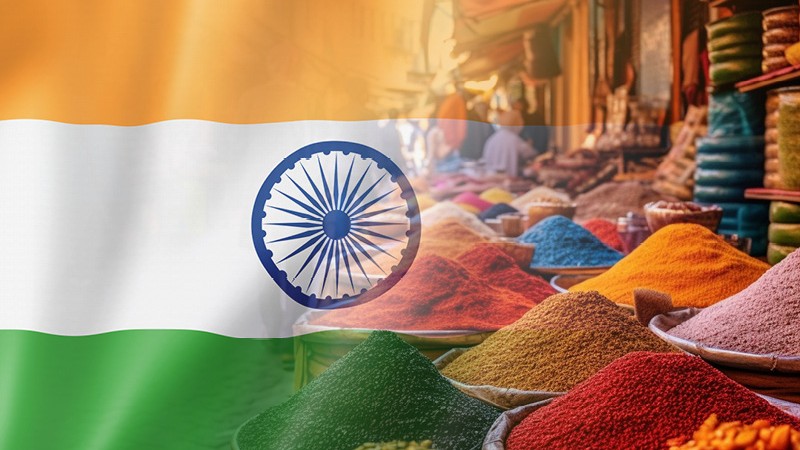Sesame seeds and Spices: „Every nation is interdependent on the other”
January 5, 2024 at 1:00 PM ,
Der AUDITOR

Which were the main difficulties faced by the Indian sesame seed and spices market in 2023? What has changed compared to the last two years?
Sesame seeds
Sesame seed trade has seen several major changes in last two years but specifically for Indian sesame seeds, the market has turned upside down. There were some minor hiccups in the path of sesame seeds, but presently, Indian sesame seeds are facing significant challenges which are threatening the future of sesame seeds.
Syndicate of China and African Nations:
Countries like Nigeria which were not equipped with the hulling infrastructure are now getting better infrastructure and the special treaties between these nations are sidelining India from the main trade. Also, Indian sesame seeds are being victimised due to the political grudges between India and China.
Korean Tenders and Pakistan:
If the last five tenders are zoomed then the results clearly indicate that India has already lost the rank and other nations like Pakistan are able to achieve a prominent place. The only reason is the price, as prices for the Indian crop are still USD 250 to 300/mt higher than in Pakistan, Nigeria and Burkina Faso.
Quality Required for Exports:
Indian cultivators are still not aware and alert to adapt good agricultural practices. The one solution visible is the intervention of the central government and implement policies which can motivate and encourage farmers. India is still facing issues of quality whether it is aflatoxins or pesticidal residues, this is barricading the movement of Indian sesame seeds to developed nations. These nations are ready to pay higher prices for the required grade but the Indian farmers show least interest to uplift the farming methods.
|
EU monthly import data from India |
||||
|
Year |
2022 |
2023 |
||
|
Month |
mt |
USD/mt |
mt |
USD/mt |
|
Jan |
1,311 |
2,240 |
1,536 |
2,289 |
|
Feb |
1,116 |
2,338 |
1,707 |
2,247 |
|
Mar |
1,598 |
2,274 |
1,750 |
2,377 |
|
Apr |
1,693 |
2,295 |
1,226 |
2,459 |
|
May |
1,913 |
2,262 |
2,306 |
2,480 |
|
June |
1,650 |
2,275 |
1,908 |
2,427 |
|
July |
1,573 |
2,095 |
1,349 |
2,510 |
|
Aug |
1,978 |
2,130 |
3,231 |
2,257 |
|
Sep |
1,956 |
2,197 |
2,358 |
2,299 |
|
Total |
14,788 |
2,223 |
17,397 |
2,359 |
|
Trade sources |
||||
The above figures depict the sharp fall in export magnitude and the future is also assumed to remain unchanged if the necessary steps to enhance the quality of sesame are not taken.
Price Rigidity:
Despite of the declining exports of sesame seeds due to higher prices the rates are not dropping to match the global price parity. Matter of fact is that the experienced traders and stockists understand that India is having the highest population and demand of sesame seeds, hence the domestic consumption can easily give them a chance to liquidate the stocks. Hence, they invest with a mindset of waiting for a very long duration.
China’s Silent Penetration:
China quietly has started conquering the sesame oil market. The oil extraction units have exponentially increased in China and are giving cut-throat competition to India, which restricting India’s growth in the oil trade. These outcomes are tremendous and rapidly changing the dynamics of the across border sales. India is not even standing 20% of the China’s export quantum. Therefore, scrutinising all the pros and cons, Indian foreign trade will see a sharp decline in the year of 2024, unless and until some major steps are taken to curb the prices and improve the quality.
Spices
The Indian spice trade has also witnessed some alterations, which will have deep and prolonged effects on the trade. First, the price volatility which has sometimes attracted to buy and seldom repelled the traders from a particular commodity. If the whole spice sector is analysed then cumin took a record-breaking growth and then fell by huge margins in the last few weeks. Similarly, turmeric took a leap by 70% in the month of July and then attained stagnancy. Hence, the volatility in the prices is constricting the circumference of the export trade.
Second, the mediocre and small traders emphasize on the point of constructing a security board which can regulate the prices and stop conspired activities performed by affluent players. There are particular clusters which target one commodity and start procuring massive stocks from all over the nation and create artificial shortage to hike the prices. Then they liquidate and the small traders and investors fall prey to that game plan.
There are enough substantial examples which can prove such gimmicks. India being the largest producer of the spices, then also due to high rates spices are needed to be imported from other nations. As cumin was imported from China and Syria, in the same way cilantro is also being imported from Russia in great volumes.
Finally, adjudicating all the factors, it is rudimentary to setup a regulatory body which can maintain uniformity in the rates and avoid overnight rise and fall in prices. Then every trader will get equal chance to execute business and some stability can be anticipated. Otherwise it will create polarity between the traders based on the investment capacity and the market will face uncertainties, which in turn affect the transactions at the local and international stage.
What impact do the wars in Ukraine and Israel have on the market? Are the political tensions in various African countries also a cause for concern here?
War always has a detrimental and devastating effect on every sector and it is a double-edged sword, not only two confronting nations suffer but the whole globe can witness the deep impact. Considering the world as a global village every nation is interdependent on the other via some or the other way. As far as the agricultural sector is concerned, it is the basic field which undergoes turmoil.
Russia-Ukraine War: This war jeopardized the agricultural trade, Russia being the prominent exporter for wheat, corn and coriander could not perform international trade with many countries and the dollar fluctuation brought the all-time highest depreciation to the Russian currency. Finally, the major victim is the dependent country, which has to suffer irrational price hike and shortages.
Israel War: Israel being a country of agricultural revolution and an innovator of hybrid technology has incurred huge losses of workforce and disruption of distribution channels. Finally, the burden of all the fights and conflicts are poured on the common man and the repercussions on the trade are lasting for years.
Hence, next year the market will remain stable and growth or major demand cannot be foreseen until the situation cools down.
In 2023, climate change and its impact on global commodity production was felt like never before. What should growers and market players be prepared for in the coming years?
Atmospheric changes are affecting agriculture commodity trade globally. The irregular spell of unwanted rains, El Nino effects and extreme moist weather has downsized the acreage of few commodities. This in turn has ballooned inflation to a higher extent and as a result the importers perform purchases only for the required quantities. Therefore, the volume of the trade keeps on changing frequently.
Further, observing the domestic deficit in a particular commodity, the governments are compelled to take overnight harsh decisions. For instance, the Indian Government implemented a ban on the exports of sugar, wheat and some varieties of rice. Therefore, starting from the exporters, shipping lines and then the dependent countries all lose businesses and prices commence to mount.
Finally, such situations can be avoided partially if the governments start to take the initiative for the modern farming practices, because every farmer is not capable or affluent for the expenditure involved in employing such methods of cultivation. Governments need to provide loans as well as the guidance to set up the infrastructure. There are various options which are seeming expensive apparently but in the long run these are most economically viable. For example greenhouse farming, multi storey method or vertical farming and drip irrigation. By using such alternatives the dependency on the other nations get reduced and market players or traders can smoothly trade for all the fronts.
Commodity prices have risen significantly in many markets for another year in a row. Inflation and higher production costs are leaving their mark; the sesame seed and spice markets are no exception here. Do you think consumers will look for cheaper alternatives in the long run?
Agricultural commodities are the rudimentary aspect of the human life and their prices have always been of great concern. Now, there are global economic crises and every nation is facing a liquidity crunch, in such times it is obvious that traders will find other sources for the lowest prices compromising with the quality to some extent. Proof of such scenario is India, where India being a nation of prominent exporters for sesame seeds and spices like cumin, but now India’s position is demoted and the international influx is increasing by a huge margin. The only reason for such change is pricing.
If deep financial adjudication is performed, then it is crystal clear that world is getting polarised on the criterion economic capability. The geopolitical situation, war and conflicts have disturbed the supply chain and the nations are compelled to take new diversions for the procurement. Therefore, the trade for high-quality crops is shrinking and low-price goods are getting penetrated to the first world countries.
Finally, one can derive a conclusion that India will face ‘Catch-22’ situation next year and mixed trends of trade will be witnessed.





